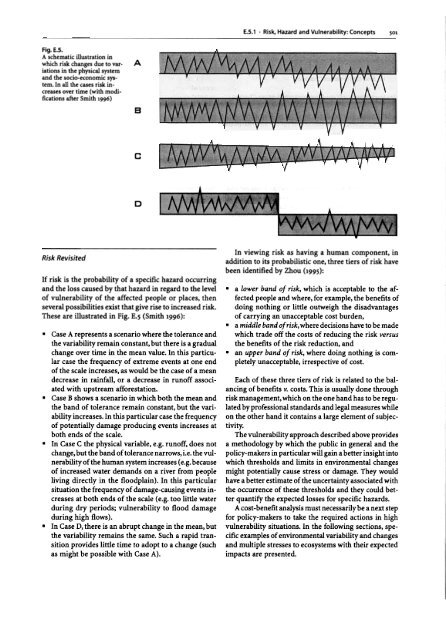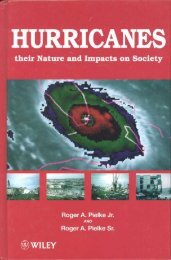How to evaluate vulnerability in changing environmental conditions
How to evaluate vulnerability in changing environmental conditions
How to evaluate vulnerability in changing environmental conditions
You also want an ePaper? Increase the reach of your titles
YUMPU automatically turns print PDFs into web optimized ePapers that Google loves.
Fig.E.S.<br />
A schematic illustration <strong>in</strong><br />
which risk changes due <strong>to</strong> variations<br />
<strong>in</strong> the physical system<br />
and the socio-economic system.<br />
In all the cases risk <strong>in</strong>creases<br />
over time (with modifications<br />
after Smith 1996)<br />
Risk Revisited<br />
If risk is the probability of a specific hazard occurr<strong>in</strong>g<br />
and the loss caused by that hazard <strong>in</strong> regard <strong>to</strong> the level<br />
of <strong>vulnerability</strong> of the affected people or places, then<br />
several possibilities exist that give rise <strong>to</strong> <strong>in</strong>creased risk.<br />
These are illustrated <strong>in</strong> Fig. E.5 (Smith 1996):<br />
.Case A represents a scenario where the <strong>to</strong>lerance and<br />
the variability rema<strong>in</strong> constant, but there is a gradual<br />
change over time <strong>in</strong> the mean value. In this particular<br />
case the frequency of extreme events at one end<br />
of the scale <strong>in</strong>creases, as would be the case of a mean<br />
decrease <strong>in</strong> ra<strong>in</strong>fall, or a decrease <strong>in</strong> runoff associated<br />
with upstream afforestation.<br />
.Case B shows a scenario <strong>in</strong> which both the mean and<br />
the band of <strong>to</strong>lerance rema<strong>in</strong> constant, but the variability<br />
<strong>in</strong>creases. In this particular case the frequency<br />
of potentially damage produc<strong>in</strong>g events <strong>in</strong>creases at<br />
both ends of the scale.<br />
.In Case C the physical variable, e.g. runoff, does not<br />
change, but the band of <strong>to</strong>lerance narrows, i.e. the <strong>vulnerability</strong><br />
of the human system <strong>in</strong>creases (e.g. because<br />
of <strong>in</strong>creased water demands on a river from people<br />
liv<strong>in</strong>g directly <strong>in</strong> the floodpla<strong>in</strong>). In this particular<br />
situation the frequency of damage-caus<strong>in</strong>g events <strong>in</strong>creases<br />
at both ends of the scale (e.g. <strong>to</strong>o little water<br />
dur<strong>in</strong>g dry periods; <strong>vulnerability</strong> <strong>to</strong> flood damage<br />
dur<strong>in</strong>g high flows).<br />
.In Case D, there is an abrupt change <strong>in</strong> the mean, but<br />
the variability rema<strong>in</strong>s the same. Such a rapid transition<br />
provides little time <strong>to</strong> adopt <strong>to</strong> a change (such<br />
as might be possible with Case A).<br />
A<br />
B<br />
c<br />
D<br />
E.S.1 .Risk, Hazard and Vulnerability: Concepts 501<br />
In view<strong>in</strong>g risk as hav<strong>in</strong>g a human component, <strong>in</strong><br />
addition <strong>to</strong> its probabilistic one, three tiers of risk have<br />
been identified by Zhou (1995):<br />
.a lower band of risk, which is acceptable <strong>to</strong> the affected<br />
people and where, for example, the benefits of<br />
do<strong>in</strong>g noth<strong>in</strong>g or little outweigh the disadvantages<br />
of carry<strong>in</strong>g an unacceptable cost burden,<br />
.a middle band of risk, where decisions have <strong>to</strong> be made<br />
which trade off the costs of reduc<strong>in</strong>g the risk versus<br />
the benefits of the risk reduction, and<br />
.an upper band of risk, where do<strong>in</strong>g noth<strong>in</strong>g is completely<br />
unacceptable, irrespective of cost.<br />
Each of these three tiers of risk is related <strong>to</strong> the balanc<strong>in</strong>g<br />
of benefits v. costs. This is usually done through<br />
risk management, which on the one hand has <strong>to</strong> be regulated<br />
by professional standards and legal measures while<br />
on the other hand it conta<strong>in</strong>s a large element of subjec-<br />
tivity.<br />
The <strong>vulnerability</strong> approach described above provides<br />
a methodology by which the public <strong>in</strong> general and the<br />
policy-makers <strong>in</strong> particular will ga<strong>in</strong> a better <strong>in</strong>sight <strong>in</strong><strong>to</strong><br />
which thresholds and limits <strong>in</strong> <strong>environmental</strong> changes<br />
might potentially cause stress or damage. They would<br />
have a better estimate of the uncerta<strong>in</strong>ty associated with<br />
the occurrence of these thresholds and they could better<br />
quantify the expected losses for specific hazards.<br />
A cost-benefit analysis must necessarily be a next step<br />
for policy-makers <strong>to</strong> take the required actions <strong>in</strong> high<br />
<strong>vulnerability</strong> situations. In the follow<strong>in</strong>g sections, specific<br />
examples of <strong>environmental</strong> variability and changes<br />
and multiple stresses <strong>to</strong> ecosystems with their expected<br />
impacts are presented.














